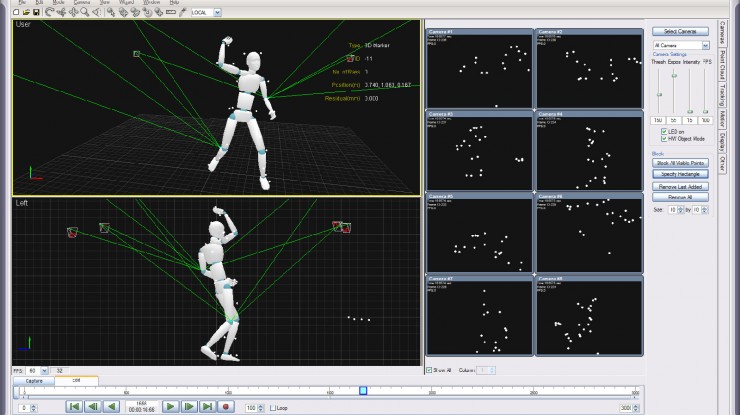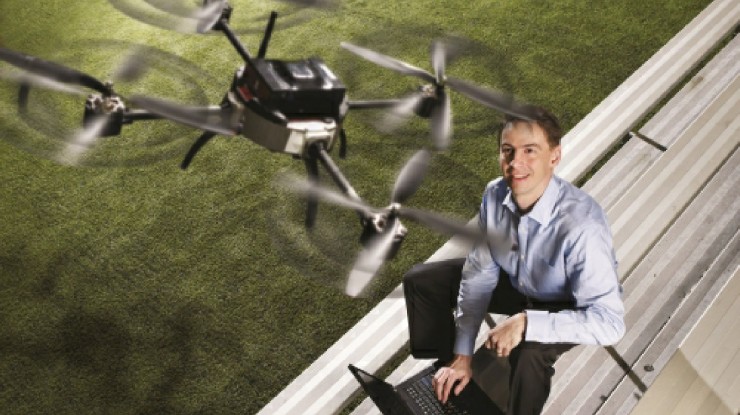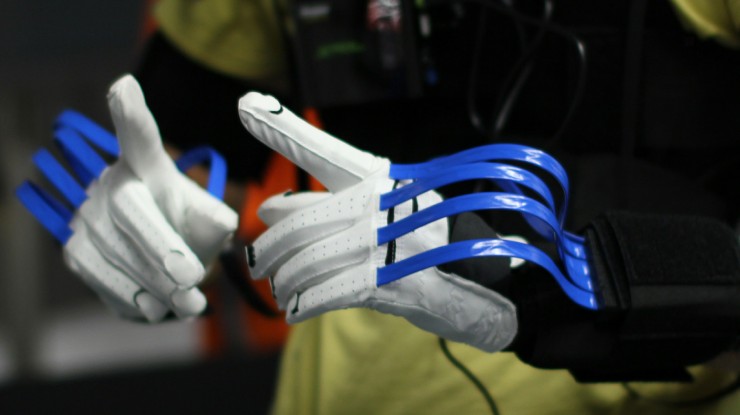1. Improving Environment Perception for Blind People
Inition suggested an inertial Shapehand glove for the researchers at the Centre for Robotics Research, King’s College London.
PhD student Giuseppe Cotugno and his team modified the glove with haptic (physical) feedback, designed to allow blind people to better perceive 3D models. A possible application could be in an exhibition where a blind visitor received physical information about an object. For example, a rare artefact in a museum that was not touchable, could be visualised by a blind person via the transfer of the ‘haptology’ of that object to the user’s hands.
2. Humanising Robots
The same department is also using the mocap glove data to contribute to the iCub initiative – a humanoid robot that can see and hear, has the sense of proprioception (body configuration) and movement (using accelerometers and gyroscopes).
Giuseppe’s work is to understand the biomechanics of the human hand and its kinematic model and how grasping is executed at the neural level.
You can see an example of this in the clip below, as the iCub attempts to grab several objects with different dexterities which is based on the recording of motion of the human hand, using the Shapehand Glove.
The data from the mocap technology is designed to give the iCub the sense of touch and to grade how much force it exerts on the environment.
Universities all over the world are using mocap technology to augment human kinetic behaviour onto humanoids. It is thought that, for robots to be successful in a human environment, they must possess similar traits.
3. Making Construction Work Safer
Optical motion capture systems are very popular with universities due to their diversity meaning they can be cost effectively shared by different departments and it was the Optitrack range Inition supplied to Heriot-Watt University Edinburgh due to its economics and SDK.
Their initial focus has been the improvement of health and safety practises in the construction industry.
Theodore Lim, from the Institute of Mechanical, Process and Energy Engineering, recently submitted a paper which details the analyses of the biomechanics associated with operating ladders, using four points of data to reveal inappropriate or incorrect usage and potential safety concerns.
Lim also sees the OptiTrack being a useful for other departments saying, “With the University of Edinburgh we jointly secured £6 million of UK government funding for research into robotics and autonomous systems last year. The OptiTrack will serve to monitor UAV swarms and to develop control strategies for collaborative interactions with each other, with humans and or animals, and with the environment.”
4. Breathing Life into Animated Characters
The School of Computing Science and Digital Media, Robert Gordon University in Aberdeen are using an Optitrack rig as part of their education system.
“What we were looking for was a system at a good price point that allow us to demonstrate to students the fundamentals of motion capture and allow them to make use of it during their studies.” said Dr. Daniel C. Doolan, the Course Leader in Computer Science.
He continued: “As a starting point we have a number of modules dealing with 3D graphics and animation hence data acquisition from the motion capture system will greatly speed up the process of creating full body animation sequences. Once some proficiency is gained in the use of the system further directions may be investigated.”
Aberdeen is generally well known as the oil capital of Europe and a number of research projects focused on this sector are being carried out by the University.
5. Making the Sick Feel More Comfortable
The University of Kent, Great Ormond Street Hospital and the University of Sheffield are collaborating to improve the lives of older people by allowing them to stay in their homes rather than hospital.
The School’s communication engineering and computer animation department, led by Dr Batchelor, is using mocap to measure the precise movement of people wearing wireless devices such as medical sensors, mobile computers and pedometers. The data acquired from this measurement will then be used to animate 3D scans of their bodies. It is these ‘avatars’, or computer-animated characters, that will allow the team to analyse how radio waves ‘creep’ around the body and from this ascertain the implications for power and battery management on wireless devices.
Dr Batchelor said: “Currently, children undergoing lengthy observations in hospitals may be ‘tethered’ by cables and wires for long periods. When I heard about this, I thought that there had to be a way to free them and other patients from their attachment to machines. By extension, new methods must also now be found to allow ill and ageing people to stay in their own homes, where many of them would prefer to be.”
6. Powering the Next Generation of Drones
Unlike the robotic application above, the University of Waterloo’s WAVELab Research Group, led Professor Steven Waslander, is using optical mocap technology, in their case, the Optitrack system, which Inition has supplied to many universities.
“We selected OptiTrack for its combination of function and affordability,” said Waslander. “Not every school can afford a $100,000 motion capture system, and honestly, they don’t need it. An OptiTrack setup gives you more than enough tracking power to realize your ambitions.”
Waslander and his team has been working out the best ways to help robot commanders get their mecha-assistants from point A to point B without the use of manual controls. Without the mocap control, those same vehicles would veer off into hazardous areas like walls. The addition of the cameras enabled the team to estimate in real time if the onboard sensors were working and the robots had stayed locked to their predetermined route.
In time, you may see WAVELab’s robots out in the world as sample collectors for scientists exploring hard-to-reach crevasses in Antarctica; or as scouts that keep soldiers safe; or even (someday) as the pilot that flies you home from a well deserved vacation (or possibly deliver your box set collection!)
7. Mocap for the Perfect Kick
For Sport Psychologist Professor Cathy Craig of Queen’s Belfast University, motion capture technology has been instrumental in her search into how the human brain controls movement and trying to come up with new innovative ways of helping people perform better.
Her work combines that with VR to control the visual information someone can see and subsequently measure how they respond to it.
In one of her projects, a mocap system was able to analyise real world rugby players to produce the perfect kick working with the Ulster Rugby Players.
This video, explains how small adjustments can be made with the help of data and ‘the ultimate sporting analysis’ to assist place kicking.
Conclusion
The above is just a snapshot of some of the very interesting applications university researchers are using mocap technology for. Whilst mocap is often associated with the computer games and film industry, its scope is far wider than that, with the potential to enhance many aspects of people’s day to day lives.




